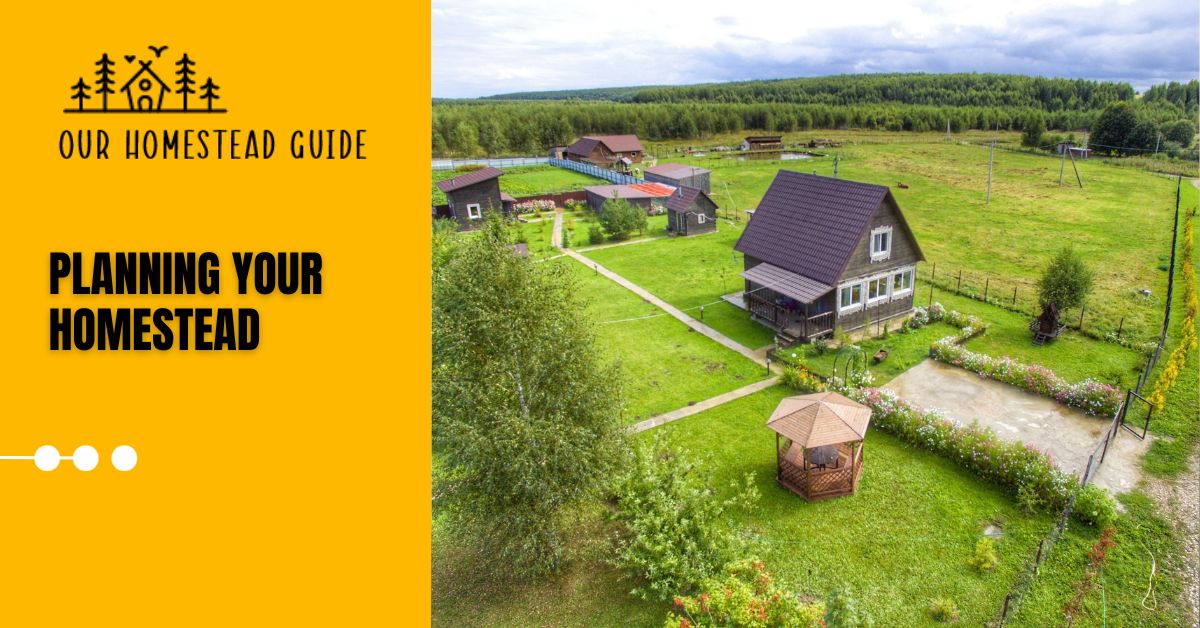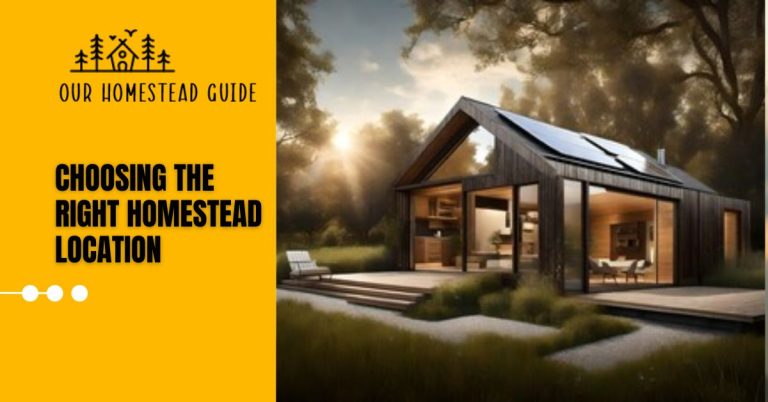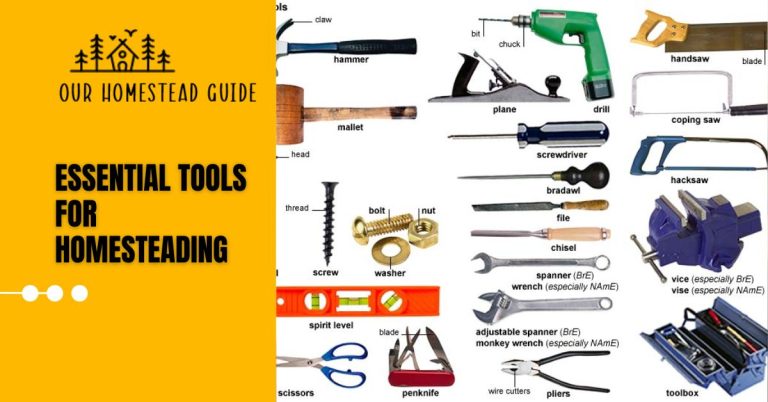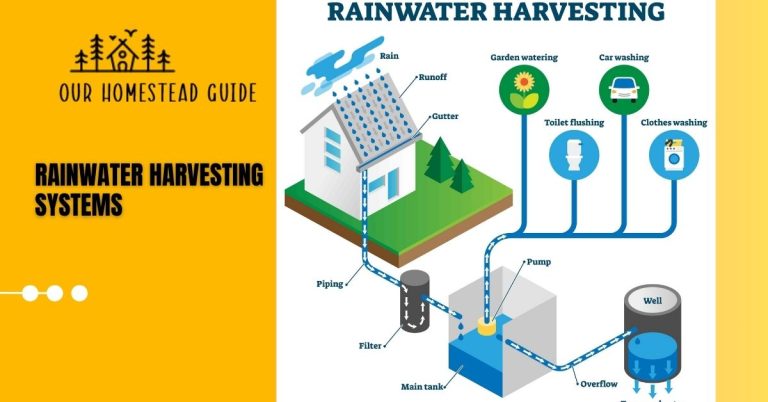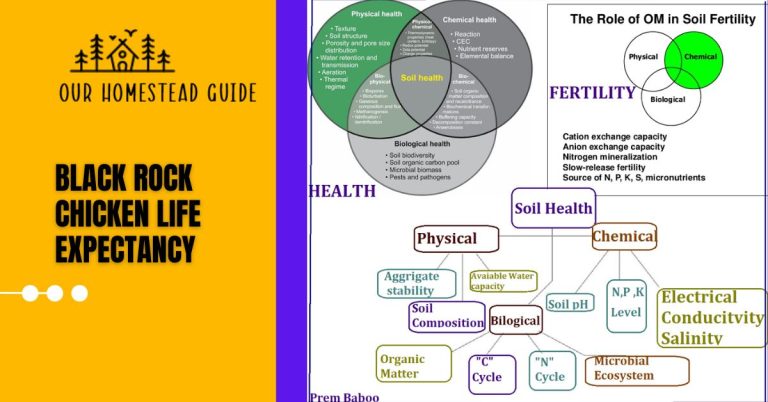15 Steps Planning Your Homestead: A Comprehensive Guide
Planning Your Homestead takes on various meanings, from cultivating a vegetable garden to achieving complete self-sufficiency. Planning a homestead involves substantial effort, with the author emphasizing not only food cultivation but also reducing dependence on services and fostering local community connections for goods exchange.
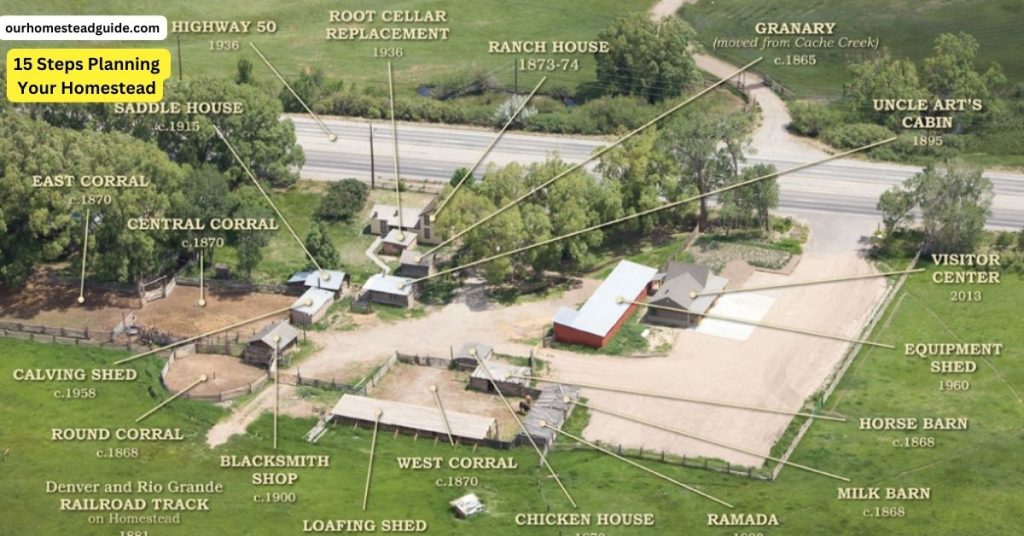
Acquiring a new piece of landmarks is the beginning of the homesteading journey, prompting a thorough exploration to determine ideal building locations, identify exemptions, and leverage advantages offered by specific areas.
Homestead Planning Things to Consider
Here’s a list of questions to ask yourself when you survey and plan your new farm using your equipment. There are a lot of questions, but you may start to see your homestead take shape by making basic sketches of what could work best.

- What is your homestead land boundaries?
- Are your pasture slopes anything 30° or less that will help you to avoid erosion issues?
- Where will you build your home?
- Where is your optimal southwest-facing slope?
- Where is a possible home spot that is 50 feet off of the bottom of the valley?
- Or where is a possible home spot 50 feet above the creek level?
- Is your possible home spot on top of the mountain? You may want to reconsider as you won’t want your home exposed to the elements, nor do you want to have to carry all of your resources up to your house.
- What sources of water are there in your area?
- Where are you going to put your animals?
- Are there any roads at all, whether they are access roads, logging roads, or real highways?
Once you have a basic understanding of some of the above-mentioned issues, you may utilize the three essential tools below to learn more about your new homestead property and obtain much-needed answers to the earlier queries.
15 Steps Planning Your Homestead
Review of the Federal Land Use Planning Process
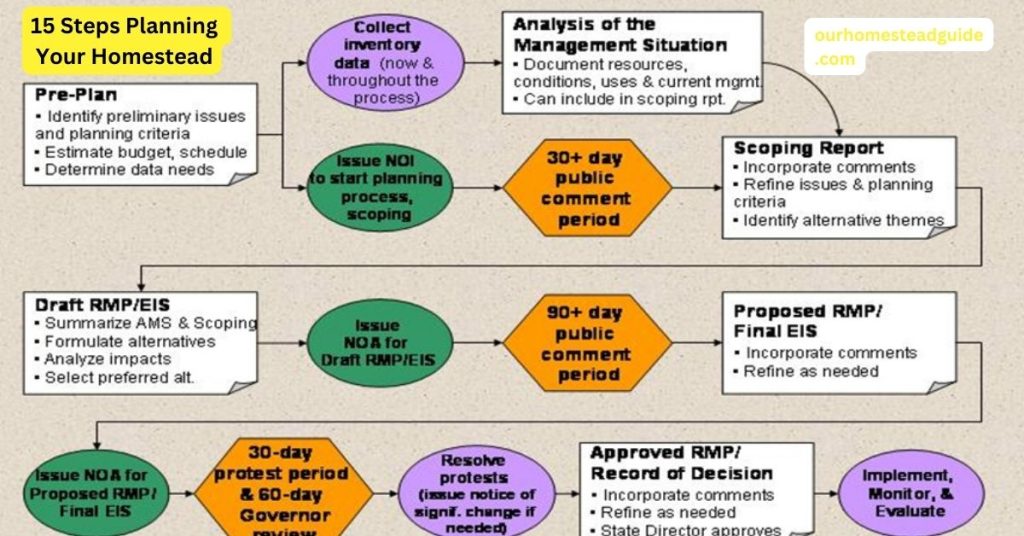
Sunny Spots are Prime Locations
The positive aspects of my first homesteading errors evolved into insightful lessons for my second, larger farm. After installing water, I began scouting my land to find sunny spots that would be perfect for a berry patch, orchard, vineyard, garden, or raised beds.

It was important to mark these locations and determine how close they were to the water supply. It became a desirable gardening area if it was hose-accessible; if not, inventive solutions were required. Selecting the ideal site and investigating cutting-edge techniques for moving water—like installing subterranean lines or mounting a watering tank on a car—became crucial actions.
Growing food on a farm requires plenty of sunlight and appropriate irrigation, so careful planning and resourcefulness are essential for a prosperous and fruitful homestead.
Water,
A homestead is defined as a piece of land with access to water. I apologize for stating this so bluntly, but that is the reality. Water is essential for survival. For their survival, your plants and animals also need water.
Finding the water supply on the land must thus be your first concern. Ideally, your land has a body of water or a well that you can utilize to supply water to your house.
In any case, never give up. You may supply water to your homestead in several ways. Determine which water solution is ideal for you by doing some research on each choice. You are prepared to begin constructing your house as soon as your water is established.
Do You Have Any Flat Spots?
Make use of the level regions on your land for construction, giving a house priority over other projects. Once you’ve chosen a place for your home, set aside additional level areas for necessary buildings such as greenhouses, sheds, barns, and chicken coops.
Make sure that animal constructions have simple access to water by planning water solutions while choosing a site for the building. Determine which areas, if not entirely level, just need to be slightly graded to become the best construction sites.
To make the most use of your homestead area, thoughtful planning that takes into account both present and future demands is essential.
Stake Off Your Pasture
Once you’ve established the location of the structures and plants on your farm, find your water supply. Choose a good spot for your animals to graze, making sure that bigger pastures can support them in the warmer months. Add more hay and garden products to their diet in fewer grazing areas.

Giving animals the freedom to wander about not only keeps them content and active but also contributes to cost-free land upkeep. If there is a shortage of grazing space, give preference to large animal buildings and smaller cattle.
Pasture spaces don’t have to be level or covered with grass; you can even plant after establishment or create woodland sections. The intention is to minimize upkeep chores while giving animals plenty of freedom to roam.
Take Down a Few Trees
Since our first farm was surrounded by trees, it received little sunshine. It took the removal of trees, the provision of firewood, building materials, and more sunshine to overcome this obstacle.
Our yard was made more spacious by the removal of trees, and it also made it possible to build a gated backyard complete with raised beds and a greenhouse. A sizable garden area was also transformed, providing storm shelter from toppling trees.
The downed trees were useful materials for building a garden shed, pig corral, woodshed, and goat shelter. Consider tree removal as a free resource to maximize your land and create useful living areas rather than as a useless endeavor.
Life on a Hill
At first, selecting level ground for our present farmhouse was simple, but a second look showed a little incline on the property. Although this created difficulties for the construction process, it did not make the land unusable. Don’t give up in locations where flat terrain is rare; utility may still be attained with a little more grading or inventive planting techniques.
In higher terrain, the fence permits cattle to graze and wander freely. Our goats are healthier when they are on a field with a slope. Hügelkultur gardening, which involves stacking logs on embankments to form mounds, is beneficial in steep areas. The mound is constructed by adding earth and compostable materials, offering a workable gardening option even on sloping ground.
Place Your Large Livestock Wisely
For better safety and visibility, think about putting smaller cattle closer to your house when placing them. Increased nighttime lighting benefits nearby goats and chickens by keeping predators away.
Larger animals, such as cows and feeder pigs, are better kept further away because of their size, enhanced resilience, and potential for harsher excrement and scents. This strategic positioning of animals improves security, visibility, and general administration and provides homesteaders with useful guidance.
Stake It Off
One of the most important aspects of good planning is to stake off your homestead land before you start to build or cultivate. This technique is important because it stresses learning from past failures when buildings were put up without a detailed strategy.
For best placement, take into account natural aspects such as shade for individual animals, making sure the arrangement meets their requirements. Moving stakes are more flexible than full, stationary constructions, allowing for changes.
By investing extra time in this visual inspection, you can ensure a thoughtful and effective plan for your homestead, avoiding regrets down the road and optimizing the use of your land.
Consider a Perimeter Fence
You must prepare for a perimeter fence while building your property. Evaluating if your house needs one and what kind best suits your budget is essential, even though it might not be the top priority owing to cost.
A perimeter fence adds protection to your property by making it difficult for intruders, whether they be humans or not.
Additionally, it helps keep your animals contained so they don’t wander off. Setting priorities for jobs according to the particular requirements and difficulties of your property will help you determine if a perimeter fence is necessary, despite the significant costs and labor involved.
Proper Fencing for Animals is a Must
For your animals’ protection and confinement, the proper animal fence is essential. Though opinions on fences are subjective, careful planning must come before building. Selecting a fence that meets your needs is essential since what suits one individual may not suit another.
A neighbor was first dubious about an electric fence for goats, but in the given situation, it worked well and was reasonably priced. Fencing should ultimately be chosen based on your judgment and the health and welfare of your animals. Your choice of fence is reasonable as long as it keeps them enclosed and safe.
How to Add Privacy When Needed
Although not every homestead property has natural seclusion, there are ways to make inventive solutions work. Although our ten-acre property is an alley-way piece, it still has neighbors at the front corners, unlike our two-acre mini-farm that employed dense tree lines to create a sense of solitude.
Positive characteristics of community and shared experiences can be fostered by neighbors. For those who value their privacy, preparation is essential. A simple, reasonably priced, and visually attractive solution for a natural privacy fence is provided by thuja trees.
Particularly beside the road or on the neighbor’s property, a hügelkultur garden offers seclusion in addition to a useful growing area. Complete isolation can be difficult to achieve, but with the right landscaping, privacy can be successfully increased without negatively impacting neighbor relations.
Don’t Forget Your Signs
Life was easy on my former property, where there were only occasional guests on a remote dirt road thanks to the dog-loving UPS driver and postal woman. I live off a paved road now, and it’s approximately five acres away. Although my new dog is amiable with people she knows, she is wary of strangers.
Despite the radial fence encircling the property, guests frequently drive up to my front porch without realizing the dog’s boundaries. To address this, I put up posters on the property warning guests who could arrive unannounced about the big dog on a radial fence, telling them to wait in the driveway and honk for help.
Create Spaces of Beauty
When evaluating and organizing your farm, remember how important it is to set apart areas for aesthetics and leisure. In the middle of the laborious tasks of homesteading, these spaces—whether it’s a flower garden, fire pit, or quiet place to take in the views—add to your well-being.
Stake off areas for relaxation and renewal in addition to gardens, structures, and animal areas to prevent burnout. My own experience has shown me how important it is to design attractive rooms and that enjoying the process is just as important as putting in the effort.
Creating spaces that are conducive to relaxation, such as a back porch overlooking the mountains, may have a big impact on balancing work and leisure time.
What To Look For When Buying A Homestead
When buying a homestead, there are a few important elements to take into account to make sure the land fits your requirements and goals. Assess the site first, including the local community, climate, and accessibility to necessary services.
Examine the land’s terrain and size, taking into account elements like soil quality and area. Examine potential sources of water, confirm their accuracy, and comprehend any related water rights. Learn about the zoning rules and building regulations in your area so that you can easily manage any potential constraints.
Examine the structures and utilities that are currently in place and how they may affect your homesteading goals. When it comes to expected agricultural operations, soil fertility must be determined by soil testing because soil quality is so important.
Recognize the growth season, climate, and any insect or animal problems in your area. Think about mobility and access, assessing the state of the roads and the distance to major transit hubs.
Finally, look into upcoming development plans and carefully evaluate your spending plan, taking into account not just the purchase price but also anticipated expenditures for development and refurbishment. This all-encompassing strategy guarantees a well-informed choice, laying the groundwork for a fruitful and satisfying homesteading endeavor.
How Much Can My Land Handle?
Evaluating your land’s capacity entails a thorough assessment of several aspects to ascertain if it is appropriate for the planned use. To determine the allowable land use, start by taking the entire area into account and being familiar with the local zoning laws.
Examine the topography, taking into account slopes and other differences in the terrain. You should also test the soil to determine its capacity for drainage and fertility. Consider wells, springs, or municipal water access when evaluating the quantity and quality of available water sources.
In addition to defining the land’s principal use—residential, agricultural, or commercial—you need also take into account the local climate and growth circumstances. Take into account the utilities, infrastructure, and animals that are already there. You should also be mindful of any prospective zoning changes or future development plans.
A complete awareness of how much your property can be managed is ensured by adopting sustainable methods and consulting professionals such as soil scientists and land surveyors. This allows for responsible and intentional land use planning.
| Key Points for Planning a 25-Acre Homestead |
|---|
| 1. Celebrating Milestones: Initiate the homesteading journey by celebrating personal milestones and transitions, such as moving to a new state, Nebraska. |
| 2. Observation of Land: Assess the five acres in focus, noting the diverse activities like geese, sheep, and evolving agricultural beds. Recognize the land’s role as an experimental ground for various edible plants. |
| 3. Diverse Elements: Encounter diverse elements during a walk through the property, including terraced garden spaces, experimental frost blanket use, and hügelkultur gardening techniques. |
| 4. Wooded Area Management: Strategically manage wooded areas through selective tree removal for creating space, sourcing firewood, and utilizing cleared land for gardening and animal shelters. Emphasize working with the land’s natural features. |
| 5. Livestock Placement: Strategically place livestock near the house for observation, protection, and ease of care. Keep smaller animals closer for visibility and protection, while larger animals are placed farther away due to size and waste considerations. |
| 6. Staking Off Areas: Emphasize the wisdom of staking off areas before construction or planting to avoid suboptimal locations for structures or gardens. |
| 7. Fencing Considerations: Consider perimeter and animal fencing for security, keeping unwanted guests out and animals within designated areas. Emphasize selecting appropriate fencing based on research and personal preferences. |
| 8. Privacy Solutions: Address privacy concerns by suggesting creative solutions like planting trees or creating hügelkultur gardens. Highlight positive experiences with neighbors, emphasizing the benefits of community connections. |
| 9. Clear Signage: Stress the need for clear signage to alert visitors to the presence of animals, especially a large dog on a radial fence. |
| 10. Designated Beautiful Spaces: Underscore the importance of creating designated beautiful spaces on the property for relaxation and rejuvenation, learning from personal burnout experiences. |
| 11. Dynamic Homesteading Journey: Summarize the narrative, depicting the homesteading journey as dynamic and ever-evolving, with a focus on sustainability, creativity, and harmonious living with nature. |
Three Useful Resources to Properly Evaluate Your Homestead
Out of all the necessary steps to begin a homestead, using a GIS map, the onX Hunt app, and having an official survey completed are the three most important ones to perform after you have your land. You will have all the precise information you want to plan the ideal homestead on your land with the help of these three outstanding tools.
Abundance+
Planning Your Homestead’ I would want to urge anyone who is considering purchasing a new homestead property but hasn’t decided to check out all we have available within Abundance+.
I have a full film addressing more of this subject inside the membership, and other veteran homesteaders share their stories and things they wish they had known before purchasing and establishing a homestead.
Use Abundance+’s complimentary seven-day trial to get started on homestead planning right away!
GIS Map of Your Property
Just to recap Enter “GIS Map + (name of your county)” into Google.
Locate the provided number and give it a call.
Request a GIS map of your land from them. You can receive a high-quality PDF file from them.
Print your map out by going to your local printer.
Get it laminated if at all feasible so you can mark and re-mark it as you plan.
The contour lines on this GIS map will indicate the approximate ten-foot rise of the boundary. It’s an excellent place to start when sketching up your designs because it’s a basic design of your house.
Pro Tip: It’s also essential to use the following resource because this map is prone to lying and inaccuracies.
onX Hunt App
You should then venture outside and explore! The next excellent tool you should utilize is the onX Hunt App.
The ideal field tool for seeing the contents of your GIS map is this app. Purchase the premium edition; it is worth the money and has several fantastic features.
This map will resemble your GIS map—in fact, it could even appear precisely the same—but the onX Hunt App will provide you with even more precise information that you can utilize because the GIS survey may be inaccurate. Here are a few of the functions and features of the app:
Waterways, access roads, and logging roads will all be visible to you.
Winter photography allows you to see nearly everything, but summer photography might obscure views above due to fully blossomed trees.
The program allows you to note fascinating objects like historic chimneys (where dwellings formerly stood), springs, and large downed trees that might need to be removed.
Additionally, you may download the app to watch content offline up to 10 square miles!
You can know whatever area of your property you’re looking at since the app keeps track of where you are.
Official Survey
Although necessary, a formal survey may be costly. Don’t forget to factor that into your budget. In my poll, an acre cost $266. Obtaining an official survey can be done for several purposes; these are listed below:
You may obtain a visual representation of the boundaries and location of your property by conducting a survey.
Unlike the GIS map or what is displayed on the onX Hunt App, a survey is legally binding.
To help you visualize your real property perimeter, the survey has the option to use ribbons to define the borders of your land.
Final Planning Tips
There is a lot of information about your homestead property that you may obtain by using the three technologies mentioned above. Here are a few last pointers:
After that, take a walk around the outside of your property. Investigate it to find out exactly what exists. Make sure you locate what you have by using your visual sense. Verify the accuracy of the maps and applications.
Take a stroll around the perimeter of your property. Determine if you need to construct any additional access roads or fencing.
Make sure you know where your land is and don’t inadvertently intrude on your neighbor’s property so that you may utilize it much more effectively.
Now gather your new tools, go exploring, and enjoy the excitement of finding and designing your own farm!
Most Frequently Asked Questions!
1. What are the initial considerations when Planning Your Homestead on a 25-acre property?
Honor your achievements and changes. Examine the property as it is now, taking note of features like sheep, geese, and agricultural plots.
2. How do you manage wooded areas on the homestead?
Remove trees one by one to make room.
Make use of freed space for building animal shelters and landscaping.
Get firewood from the regions with controlled forests.
3. What is the significance of staking off areas before construction or planting?
Plan and mark off areas to ensure that no building or garden is placed in an inconvenient position.
4. How should livestock be strategically placed on the homestead?
Smaller animals should be kept closer to the home for safety and visibility.
When placing larger animals, take into account their size, waste output, and scents.
5. What considerations are essential for fencing on a homestead?
For security, think about installing a perimeter fence.
Based on personal tastes and research, select the right fence.
6. How can privacy be enhanced on the homestead?
Create hügelkultur gardens or plant trees to provide natural seclusion.
Talk about your good experiences with your neighbors and stress the value of having ties to the community.
7. Why is clear signage important on a homestead?
Make sure guests are informed that animals are there, particularly big dogs on radial fences.
8. How can burnout be avoided on the homestead?
On the land, set aside lovely areas for rest and renewal.
Take lessons from past mistakes to slow down and savor the experience of homesteading.
9. How would you summarize the homesteading journey on a 25-acre property?
dynamic and always changing procedure.
Prioritize innovation, sustainability, and coexisting peacefully with the environment.

